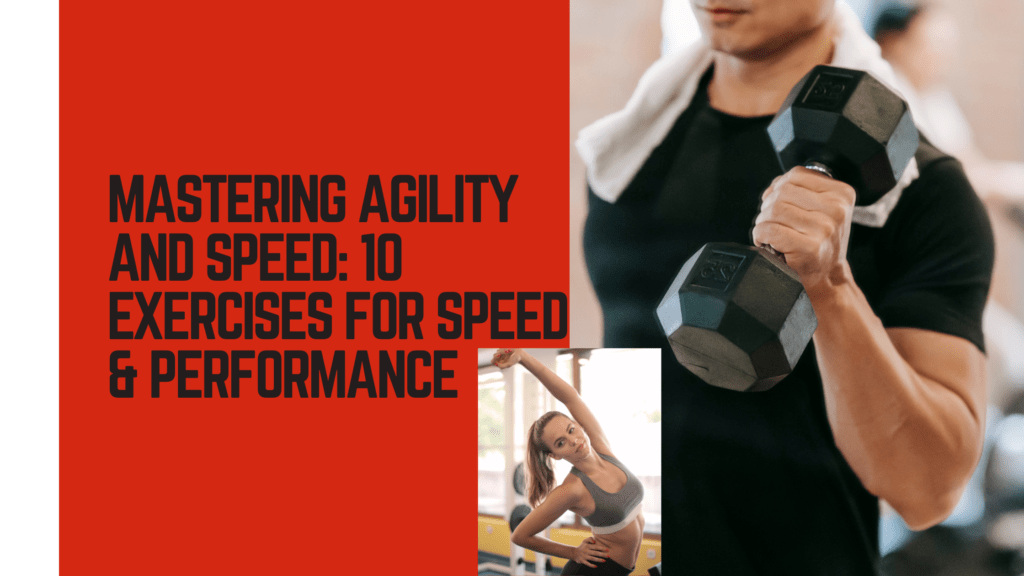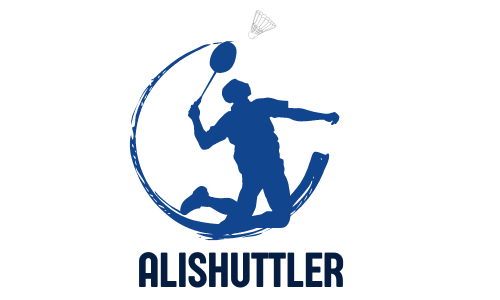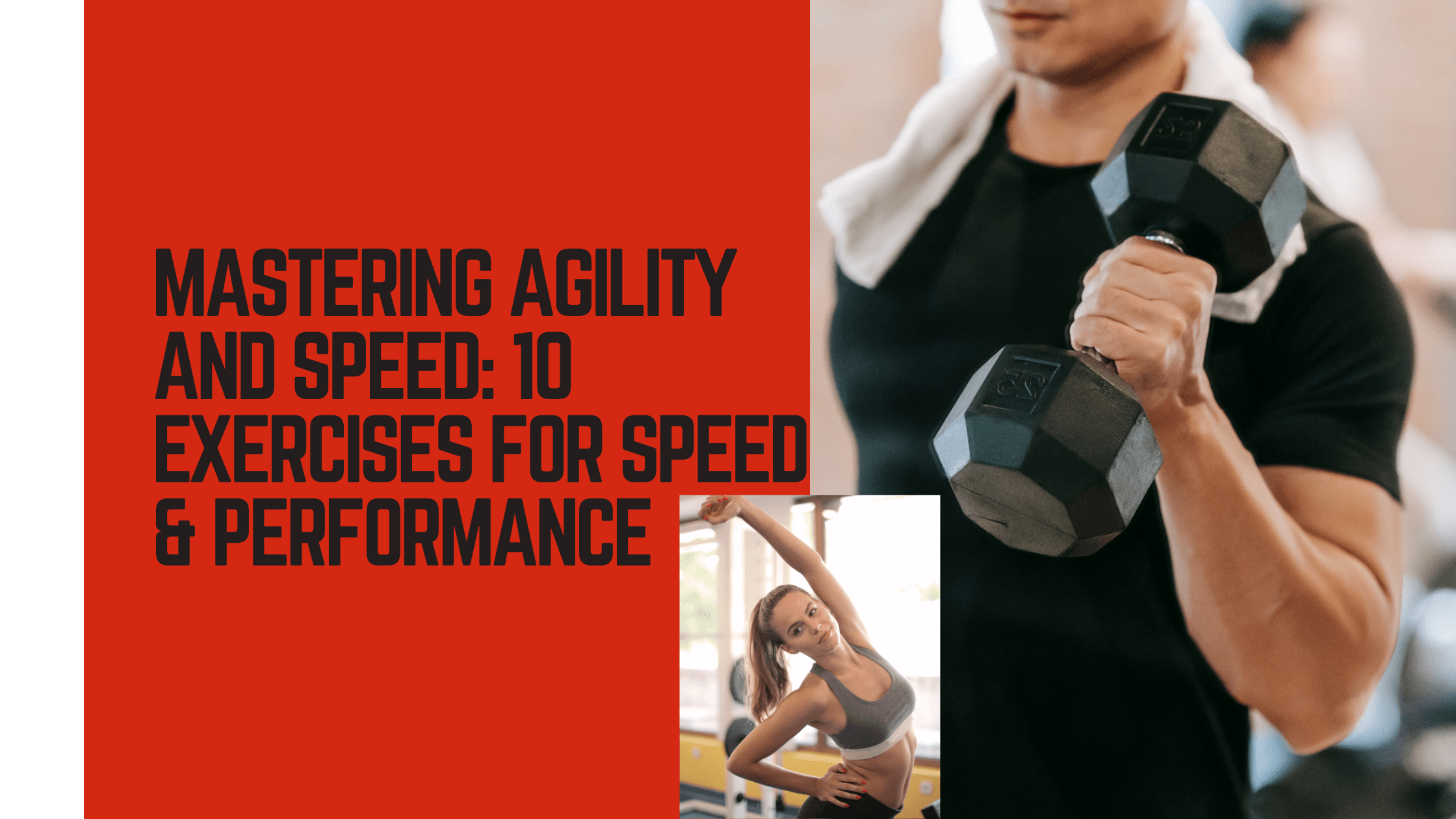Are you ready to take your athletic performance to the next level? Here’s the secret: mastering agility and speed, especially for field sport athletes. It’s not just about being fast; it’s about being lightning-quick and nimble on your feet, which is crucial for sprints and acceleration. Whether you’re a soccer player dodging defenders or a basketball player weaving through opponents, agility and speed can make all the difference.
In sports, agility, speed, sprints, and acceleration are more than just buzzwords; they are game-changers. They enable players to react swiftly, change direction effortlessly, and outmaneuver their opponents. But how do you develop these skills? That’s where mastering agility, speed, sprints, and acceleration come in.
By focusing on specific training techniques like quick footwork drills, explosive starts, and general warm-ups tailored to enhance flexibility, you can unlock your full athletic potential in sprints. Imagine being able to accelerate faster off the blocks or cut sharply around corners with precision in any sport. With dedication and the right approach, you can become a force of nature as an athlete on any field or court through exercise.
So, get ready to leave your competition in awe as you unleash your newfound mastery of sprinting, exercise, agility and speed. It’s time for field sports athletes to step up their game with the ball!
Table of Contents
Benefits of Working with a Certified Speed and Agility Coach:
Access to expert guidance tailored to individual needs
Working with a certified coach can make all the difference for field sport athletes. These coaches have extensive knowledge and experience in speed training, helping individuals reach their athletic goals. They understand that each person is unique and requires personalized guidance to maximize their potential, especially when it comes to speed drills with the ball.
With a certified coach by your side, you’ll have access to expert advice that is specifically tailored to your individual needs as an athlete. Whether you’re looking to increase your sprint speed on the field or enhance your agility for quick direction changes in your sport, a coach can provide you with targeted training techniques that will help you achieve optimal results in acceleration.
Enhanced training techniques for optimal results
Certified coaches are well-versed in the latest training methodologies and techniques for athletes. They stay up-to-date with advancements in sports science, ensuring that they can offer you the most effective strategies for mastering acceleration and speed. By incorporating innovative exercises into your work program, these coaches can help you push past your limits and break through plateaus.
Coaches also bring a fresh perspective to your sport workouts, introducing new drills and challenges that keep you engaged and motivated as an athlete. Their expertise allows them to identify areas where you may be lacking or struggling on a warm day, providing focused attention on those aspects of your performance. This targeted approach ensures that every minute of your training session is spent efficiently, maximizing the benefits gained from each exercise.
Increased accountability and motivation through professional coaching
One of the key advantages of working with a certified coach in speed training is the increased level of accountability they provide for athletes. When athletes are left to train on their own for their sport, it’s easy to let excuses get in the way or lose focus on speed drills. However, having a coach who holds athletes accountable ensures they stay committed to their goals in speed training.
A certified coach is essential for athletes looking to improve their speed training. They serve as mentors and motivators, pushing athletes to give their best effort in their sport. With their constant support and encouragement, athletes strive for continuous improvement in their speed work.
Enhancing Performance: Ways to Improve Speed and Agility
To truly master agility, acceleration, and speed in sport, there are several key factors to consider. By incorporating proper warm-up routines, athletes can effectively prevent injuries and optimize their performance. Implementing interval training is another crucial aspect that enhances both speed and endurance. Focusing on technique refinement allows athletes to maximize efficiency in their movements.
Here are some ways to improve speed and agility:
- Incorporate proper warm-up routines: Before engaging in any physical activity, it is essential to warm up the body adequately. This can include dynamic stretches, jogging, or performing exercises that activate the muscles you’ll be using during your workout or game.
- Implement interval training: Interval training involves alternating between high-intensity bursts of work and periods of rest or lower intensity. This type of training improves cardiovascular fitness, accelerates fat burning, and enhances speed by challenging your body’s ability to change direction quickly.
- Focus on technique refinement: Perfecting your technique is crucial for optimizing speed and agility. Pay attention to your posture, ensuring it is aligned correctly while performing drills or movements. Work on specific aspects such as quick acceleration from a standing start or explosive lateral movements from side to side.
By regularly practicing speed training and incorporating speed work into their training routines, athletes can significantly enhance their performance. Remember that consistency is key; warm up before each session to yield the best results.
Agility Exercises for Enhanced Performance
Enhancing agility and speed is crucial for field sport athletes to excel in their game. By incorporating specific exercises into their training routine, athletes can improve footwork coordination, quick direction changes, and explosive power development. Here are some effective warm-up agility exercises that can help athletes enhance their performance on the field.
- Ladder drills are a great way to improve footwork coordination and speed training. Athletes can warm up with quick feet, lateral movements, and high knee raises by performing various movements through a ladder-like structure on the ground.
- Speed training cone drills: By utilizing cones placed strategically on the field, athletes can enhance their speed work and ability to change directions rapidly. This warm-up exercise involves weaving in and out of cones or performing figure-eight patterns around them.
- Plyometric exercises: Plyometrics involve explosive movements that develop power, speed, and warm. Examples include box jumps, depth jumps, and bounding exercises. These warm exercises help athletes generate maximum force in minimal time.
By regularly incorporating these warm agility exercises into their training regimen, field sport athletes can enhance their performance on the field. They will develop better footwork coordination, an improved ability to change directions quickly, and increased explosive power.

Remember to consult with a professional trainer or coach before attempting any new exercise routine to ensure proper form and prevent warm injuries. With consistent practice and dedication, mastering agility and speed is within reach for every athlete striving for warm excellence.
Now it’s time for athletes to hit the field and engage in speed training to unleash their full potential with speed work!
Guide to Mastering Agility and Speed Techniques:
Breaking down fundamental movements like pivoting, cutting, and backpedaling
To master agility techniques and improve speed, it is crucial for an athlete to start by breaking down the fundamental movements involved in speed training. This includes understanding the mechanics of pivoting, cutting, and backpedaling. Pivoting involves quickly changing direction on one foot while maintaining balance and control during speed work. Cutting refers to sharp changes in direction while running or moving laterally in speed training. Backpedaling requires moving backward rapidly while keeping a low center of gravity for quick reactions during speed work.
Practicing change-of-direction drills with varying levels of difficulty
Once the fundamental movements are understood, it is essential for athletes to practice change-of-direction drills at various difficulty levels. These drills help improve coordination, speed, and reaction time for athletes. Examples of such drills include the 5-10-5 shuttle drill, cone drills with random pattern changes, ladder agility exercises, and zig-zag sprints. By regularly challenging themselves with different levels of difficulty in these drills, athletes can enhance their overall agility.
Utilizing visual cues and reaction time exercises for improved responsiveness
Another key aspect of mastering agility techniques in speed training is improving responsiveness through visual cues and reaction time exercises. Visual cues involve focusing on specific targets or objects that prompt quick reactions and changes in direction for the athlete. Reaction time exercises can include partner drills where you react to their movements or using tools like reaction balls or lights that require rapid responses during speed work.
By incorporating visual cues and reaction time exercises, athletes can sharpen their reflexes and become more agile on the field or court.
Incorporating Resistance Training for Speed and Agility Improvement:
To master agility and speed, incorporating resistance training into your workout routine is essential. This type of training helps athletes build strength and power, enabling them to perform at their best. Here are some key ways to incorporate resistance training for speed and agility improvement:
- Using resistance bands or sleds is an effective way for athletes to increase muscular strength and power. Resistance bands and sleds challenge muscles in new ways, improving speed and agility.
- Performing weighted exercises is essential for athletes looking to improve their agility. By incorporating weights like dumbbells or kettlebells into exercises such as lunges, squats, or lateral hops, athletes can enhance the strength and stability required for quick directional changes.
- Balancing resistance training with flexibility exercises is essential for athletes. While building strength is important for optimal performance, maintaining flexibility is equally crucial. Incorporate stretching routines that focus on improving mobility in areas like the hips, ankles, and shoulders. This balance between resistance training and flexibility work will help prevent injuries while maximizing speed and agility gains for athletes.
Incorporating resistance training as a component of your overall conditioning program is a key reason why athletes can master agility and speed effectively. By utilizing tools like resistance bands or sleds, performing weighted exercises targeting specific muscle groups, and balancing this with flexibility work, you’ll be well on your way to enhancing your athletic performance.
So why wait, athlete? Start incorporating these strategies into your training routine today to unlock your full potential on the field or court!
Strengthening the Feet and Addressing Deficiencies in Workouts:
Foot strength plays a crucial role in enhancing athletic performance. Neglecting this aspect can hinder an athlete’s overall abilities. To optimize agility and speed, it is essential for athletes to focus on exercises that target ankle stability, arch support, and toe dexterity.
Importance of foot strength in agility performance
- Strong athlete feet provide a solid foundation for quick movements and rapid changes in direction.
- Well-developed foot muscles contribute to improved balance and coordination in athletes.
- Adequate foot strength helps prevent injuries such as sprains or strains during dynamic movements.
Exercises focusing on ankle stability, arch support, and toe dexterity
- Ankle Stability:
- Perform ankle circles or alphabet exercises to improve mobility and strengthen the ankle joint.
- Practice single-leg balance exercises like standing on one leg while maintaining proper posture.
- Arch Support:
- Use supportive shoes with proper arch support or consider using orthotic inserts if needed.
- Perform towel scrunches by placing a small towel under your feet and gripping it with your toes.
- Toe Dexterity:
- Practice toe curls by picking up objects with your toes or scrunching a towel solely using them.
- Perform toe taps where you alternate tapping each toe against the ground.
Identifying common deficiencies in workouts
To maximize agility gains, it’s crucial to address potential deficiencies in your training routine:
- Neglecting lower body mobility:
- Incorporate dynamic stretching exercises into your warm-up routine to enhance flexibility.
- Include exercises like lunges, squats, or leg swings to promote optimal lower body mobility.
- Lack of balance training:
- Integrate balance-focused activities such as yoga poses or single-leg stances into your workouts.
- Utilize unstable surfaces like balance boards or foam pads to challenge stability further.
By acknowledging these deficiencies and incorporating the appropriate drills and exercises, you can master agility and speed to elevate your athletic performance.
Remember, podcasts can be a valuable resource for learning more about foot strengthening exercises, proper form, and injury prevention techniques. So, consider tuning in to relevant podcasts that offer expert insights on this topic.
Mastering Agility and Speed:
In conclusion, mastering agility and speed is essential for athletes looking to enhance their performance. Working with a certified speed and agility coach offers numerous benefits, such as personalized training programs and expert guidance. By incorporating agility exercises into their workouts, athletes can improve their overall performance on the field or court.
To master agility techniques, athletes should focus on proper form and technique while performing drills. Resistance training is also a valuable tool for improving speed and agility. By adding resistance bands or weights to their workouts, athletes can challenge their muscles and increase their power.
Strengthening the feet and addressing any deficiencies is crucial for optimal performance. This can be achieved through specific exercises targeting the feet, such as toe raises or balance drills.

In summary, mastering agility and speed requires dedication and focused training. Athletes must work closely with a certified coach who can provide personalized guidance. By following proper techniques, incorporating resistance training, and addressing foot strength deficiencies, athletes can significantly enhance their performance.
Take your athletic abilities to new heights by mastering agility and speed today!
FAQs
Q: How long does it take to see improvements in agility and speed?
A: The time it takes to see improvements in agility and speed varies from person to person. However, with consistent training and dedication, noticeable improvements can be seen within a few weeks or months.
Q: Can anyone benefit from working with a certified speed and agility coach?
A: Yes! Whether you’re an aspiring athlete or someone looking to improve your fitness level, working with a certified coach can benefit anyone who wants to enhance their agility and speed.
Q: Are there any age restrictions for mastering agility techniques?
A: No! Agility techniques can be mastered at any age. It’s never too late to start working on your agility skills regardless of your current fitness level or age.
Q: Can resistance training help prevent injuries?
A: Yes! Resistance training not only improves speed and agility but also helps strengthen muscles, tendons, and ligaments. This can reduce the risk of injuries during athletic activities.
Q: Are there specific agility exercises for different sports?
A: Yes! While there are general agility exercises that benefit athletes in various sports, certain drills can be tailored to specific sports’ movements and requirements. Consulting with a certified coach can help identify the most suitable exercises for your sport.

